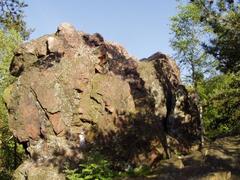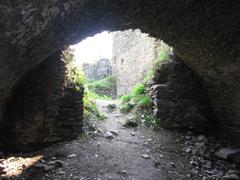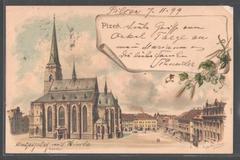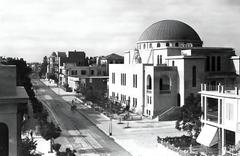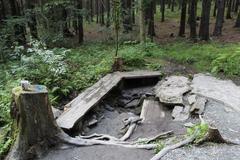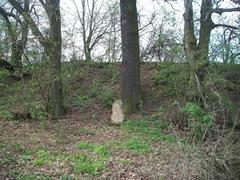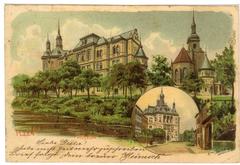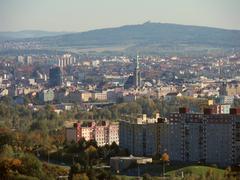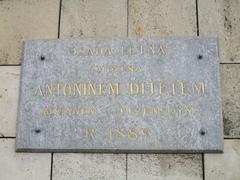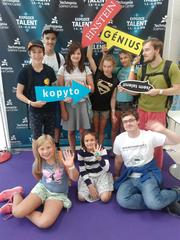
Comprehensive Guide to Visiting the Victims of Evil Monument, Plzeň, Czech Republic
Date: 23/07/2024
Introduction
The Victims of Evil Monument in Plzeň, Czech Republic, serves as a solemn tribute to the countless individuals who suffered under the brutal regimes of the 20th century, particularly during the Nazi occupation and the subsequent Communist era (Radio Prague International). Erected in the aftermath of the Velvet Revolution, which marked the end of Communist rule in Czechoslovakia, the monument stands as a powerful symbol of resilience and remembrance. Designed by the renowned Czech sculptor Jaroslav Šindelář, the monument’s abstract, angular forms poignantly capture the suffering and strength of the victims it commemorates (Plzeň.eu).
Located in Borský Park, the monument is accessible year-round and provides visitors with an opportunity to reflect on the darker chapters of Czech history while also exploring the rich cultural heritage of Plzeň. This guide offers comprehensive information on the monument’s history, visiting hours, travel tips, and nearby attractions, ensuring that visitors can make the most of their visit (Holocaust.cz).
Table of Contents
- Introduction
- History of the Victims of Evil Monument
- Visitor Information
- Practical Information
- FAQs
- Conclusion
- Visit and Stay Up to Date
History of the Victims of Evil Monument
Origins and Inception
The Victims of Evil Monument was conceived in the early 1990s, following the Velvet Revolution of 1989, which marked the end of Communist rule in Czechoslovakia. The newfound freedom allowed for a public reckoning with the past, leading to the establishment of memorials dedicated to the victims of totalitarian regimes. The monument was officially unveiled on May 8, 1995, coinciding with the 50th anniversary of the end of World War II in Europe (Radio Prague International).
Design and Construction
The monument was designed by the renowned Czech sculptor Jaroslav Šindelář. The design process began in 1991, and the monument features a stark, abstract design that evokes the suffering and resilience of the victims. It is composed of a series of jagged, interlocking metal plates, symbolizing the fractured lives and enduring strength of those who suffered under oppressive regimes (Plzeň.eu).
Historical Context
Nazi Occupation
Plzeň, like much of Czechoslovakia, was occupied by Nazi Germany from 1939 to 1945. During this period, the city witnessed numerous atrocities, including the persecution and deportation of its Jewish population. The Nazis established several concentration camps and forced labor camps in the region, where thousands of people were subjected to inhumane conditions and brutal treatment. The Victims of Evil Monument serves as a memorial to these individuals, ensuring that their suffering is not forgotten (Holocaust.cz).
Communist Regime
Following the end of World War II, Czechoslovakia fell under Soviet influence, leading to the establishment of a Communist government in 1948. The Communist regime was characterized by political repression, censorship, and the persecution of dissidents. Many individuals were imprisoned, and the monument commemorates their suffering and resilience.
Visitor Information
Tickets and Visiting Hours
The Victims of Evil Monument is open to the public year-round. There is no admission fee, making it accessible to all visitors. Visiting hours are generally from 9 AM to 6 PM, but it is advisable to check the official website or local listings for any changes or special events.
Travel Tips and Nearby Attractions
Plzeň is a city rich in history and culture. After visiting the monument, consider exploring other historical sites such as the Great Synagogue, the Plzeň Historical Underground, and the Cathedral of St. Bartholomew. Public transportation and guided tours are available, making it easy to navigate the city (Visit Plzeň).
Special Events and Guided Tours
Throughout the year, the monument hosts various events and guided tours that provide deeper insights into the historical context and significance of the site. Check the official website for schedules and booking information.
Photographic Spots
The Victims of Evil Monument offers several excellent spots for photography. The abstract design and the serene surroundings make it a compelling subject for both amateur and professional photographers.
Practical Information
Opening Hours and Admission
The monument is open to the public 24 hours a day, seven days a week, with no admission fee. Donations are welcome and can be made at the nearby information center to support the monument’s maintenance and preservation (Plzeň.eu).
Safety and Etiquette
Visitors should observe respectful behavior by maintaining a quiet demeanor, not littering, and refraining from climbing on the structures. Photography is allowed, but visitors should be mindful of others who may be there to reflect and pay respects. Check local guidelines and restrictions, especially concerning public health (Czech Republic Travel).
Local Amenities
Nearby amenities include cafes, restaurants, and restrooms. The adjacent park provides a peaceful setting for relaxation and contemplation. The Plzeň tourist information center offers souvenirs and educational materials, including books, postcards, and historical guides (Visit Plzeň).
FAQs
Q - What are the visiting hours for the Victims of Evil Monument?
A - The monument is generally open from 9 AM to 6 PM. Please check the official website for any updates.
Q - Is there an admission fee to visit the monument?
A - No, the Victims of Evil Monument is free to visit.
Q - Are guided tours available?
A - Yes, guided tours are available. Check the official website for more details.
Q - What other attractions are nearby?
A - Nearby attractions include the Great Synagogue, the Plzeň Historical Underground, and the Cathedral of St. Bartholomew.
Q - Is the monument wheelchair accessible?
A - Yes, the monument and Borský Park are accessible, with paved paths and accessible restrooms.
Conclusion
The Victims of Evil Monument in Plzeň stands not only as a memorial to the victims of totalitarian regimes but also as a testament to the enduring spirit and resilience of the Czech people. Its abstract design and poignant symbolism offer a deeply moving experience for visitors, encouraging reflection and understanding of the historical atrocities that occurred during the Nazi and Communist eras (Czech Tourism).
With no admission fee and year-round accessibility, the monument is an essential stop for anyone interested in history, culture, and human rights. Nearby attractions such as the Great Synagogue and the Plzeň Historical Underground further enrich the visitor experience, offering a broader understanding of the city’s historical and cultural landscape (Visit Plzeň). Whether you are a history enthusiast, a student, or a casual traveler, the Victims of Evil Monument provides a profound and educational visit that underscores the importance of remembering and learning from the past.
Visit and Stay Up to Date
For more information and updates on visiting the Victims of Evil Monument, download the Audiala mobile app, check out our other related posts, or follow us on social media.


